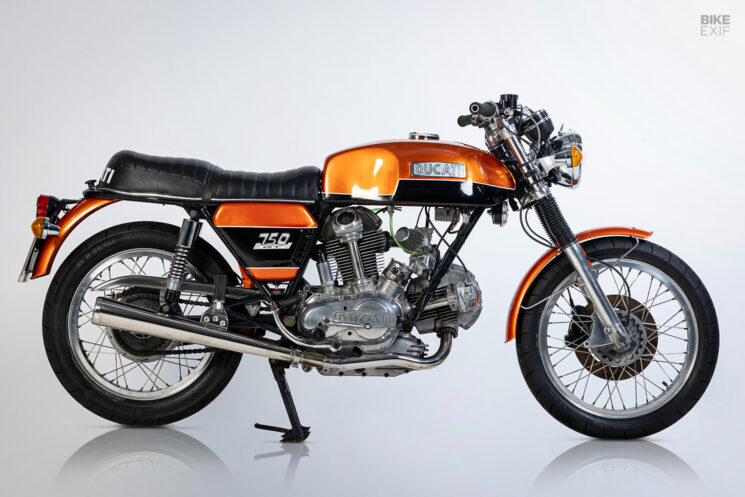
Bonhams certainly knows how to pick ’em, and there’s some exceptional iron hiding in the 2023 December Sale. It’s an online-only auction with lots closing as soon as December 11th, boasting exceptional classics, landmark sportbikes, parts and memorabilia. The apple of our eye has to be Lot 128, a sweetheart of a 1974 Ducati 750 GT, but we’ll let you be the judge.
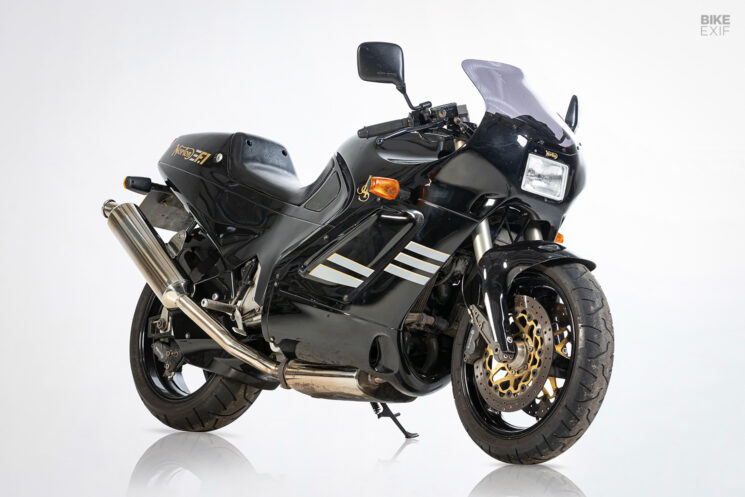
1990 Norton 588 cc F1 Amid tough financial times in the 1980s, Norton was clinging to utilitarian rotary-powered roadsters like the Interpol 2, the Classic and the Commander to weather the coming years. There was a surprising amount of potential hidden in the humble 588 cc twin-rotor Wankel, though, and the engine would eventually form the basis of the British F1-winning RCW588. Never one to waste an opportunity, Norton debuted a street-legal version of RCW in 1989 dubbed the F1.
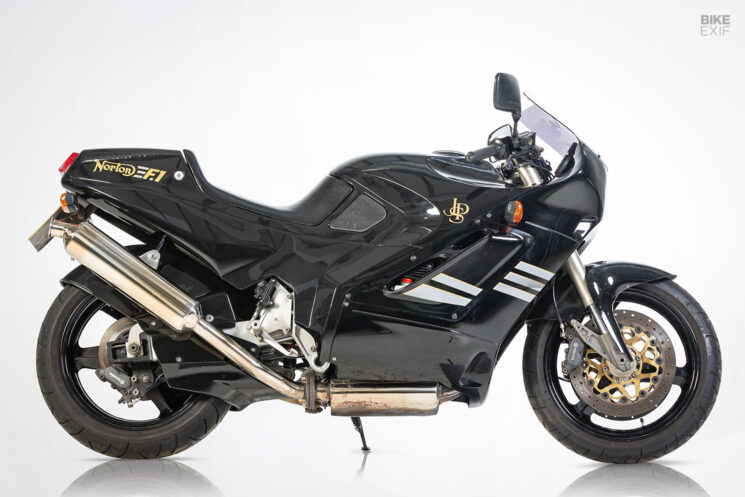
While the F1’s rotary power plant certainly makes it interesting today, it was without a doubt the most exotic superbike of its day when new. The twin-rotor Wankel engine was hopped up over the standard Commander with bigger ports, more aggressive timing, Mikuni carburetors and a five-speed gearbox from the Yamaha FZR1000. With 95 bhp at 9,500 rpm, the F1’s engine was ten numbers up from the standard Norton rotary, but significantly short of the RCW’s 140.
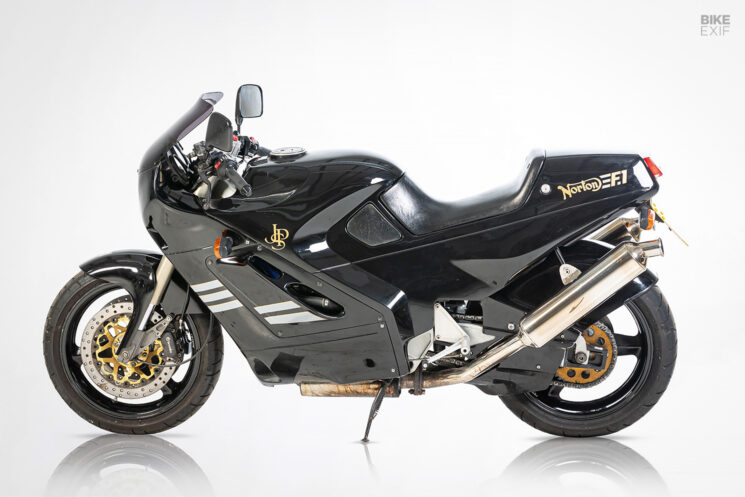
Like the RCW, the F1 rode on a trick aluminum chassis from Spondon Engineering, and was fit with a WP inverted fork and a mono-shock swingarm. Alloy wheels were sourced from PVM, brakes were Brembo and its twin-exit exhaust was full stainless. Fully-enclosed fiberglass bodywork disguised the majority of the F1’s tech, and was only available in black with John Player Special decals.

With so much trickle-down race tech in the formula, Norton never really had time to work all the bugs out of the F1. It went like stink, providing excellent mid-range performance and silky smooth acceleration, but could be a bit temperamental around town. Its MSRP was also a bitter pill, selling for £12,700 [$15,993], and just 140 were built.
Bonhams’ Lot 124 is a well-preserved example of this landmark rotary Norton with 14,587 miles on the clock. Other than a few modifications to keep the power plant healthy, the F1 appears to be in great original condition, and Bonhams estimates it will sell for £15,000 to £20,000 [$18,889 to $25,185].
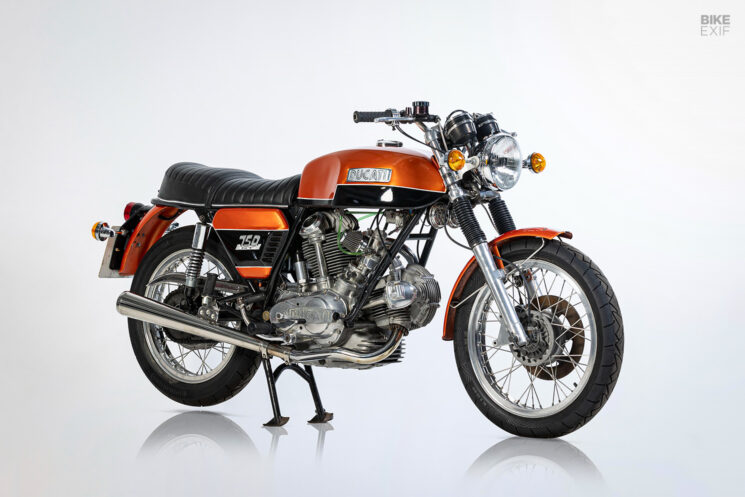
1974 Ducati 750 GT Ducati had a good thing on its hands with a long line of successful road racing singles in 1960s, but the landscape was changing quickly. Japanese multis were becoming the new performance standard, and the expanding U.S. market demanded larger cc machines. Chief engineer Fabio Taglioni started work on a new 90-degree, 750 cc L-twin engine to help Ducati break into the superbike scene in 1970, and the resulting 750 GT would prove to be a landmark accomplishment in his career.

Taglioni’s design was essentially two 350 cc bevel-drive singles in a shared crankcase, with a final displacement of 748 cc. While the 90-degree arrangement would necessitate a lengthened chassis, it kept the center of gravity low and promoted sufficient cooling for both cylinders. Output was a satisfactory 60 hp, and the engine proved so reliable in testing, that Ducati put the new 750 GT into production in June of 1971.
The 750 GT provided sporty performance and handling that outclassed Japanese multis right out of the gate, and the design would go largely unchanged through the model’s production run from 1971 to 1974. Furthermore, the 750 GT paved the way for other legendary bevel twins like the 750SS and 900SS, but that’s another story.
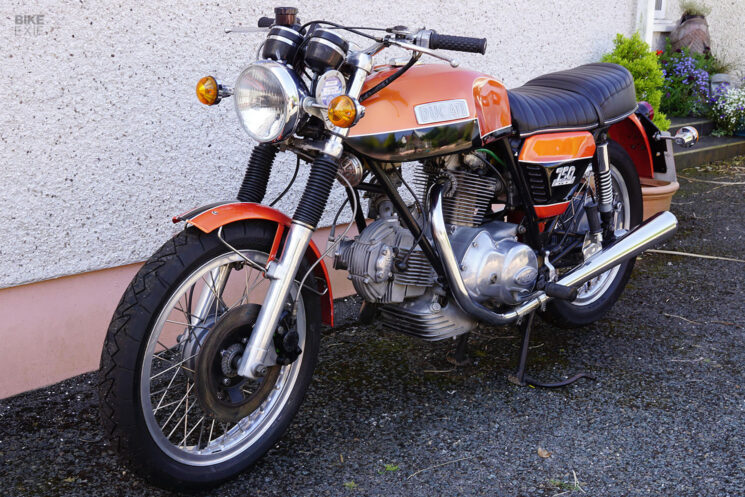
Exhibiting timeless charm and top-quality craftsmanship and specification, L-twin 750s have always been sought-after machines, and Lot 128 has lived an interesting life. It’s a one-owner 1974 model, which was registered on the Isle of Man in 1975 under ‘MAN 185F.’ Various controls, lighting and electronics have been upgraded over the years, but it’s done with period components and doesn’t hurt the bike’s curb appeal in our opinion. Of all the motorcycles in Bonhams’ December 2023 Sale, this one has to be my pick, and Bonhams estimates it will sell for £16,000 to £20,000 [$20,184 to $28,125].

1939 Triumph 498 cc Tiger 100 Lot 117 wasn’t built to be collectible—it’s no special edition or race replica—but instead, this Triumph has risen to collector status for its impact on the British motorcycle industry. As a first-year example of Edward Turner’s perfected parallel-twin design, this Triumph Tiger 100 laid the foundation for the next 30 years of Triumph motorcycles.
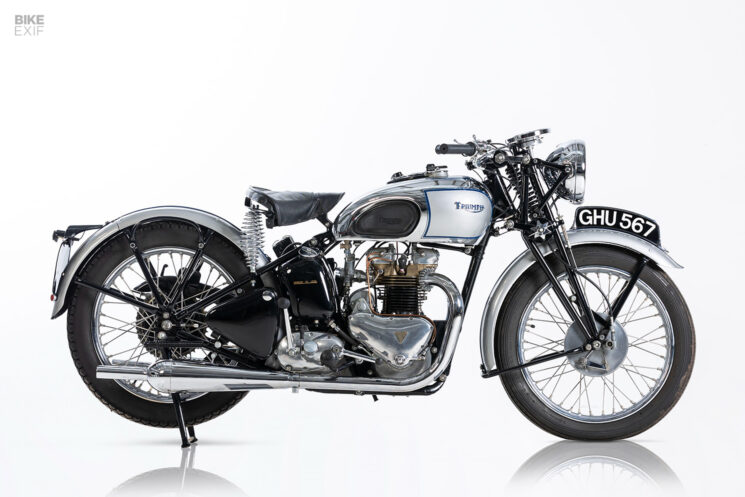
Turner came to Triumph after his time at Ariel where he designed the Square Four. Hardheaded but pragmatic, Turner sought to make Triumph stand out from the other British manufacturers by developing an all-new engine with fresh marketability, but he recognized the need to make it work with Triumph’s existing chassis designs. A parallel twin like Val Page’s 6/1 could be the ticket, but Turner needed to make it more compact and less complex.
Turner accomplished just that in 1938 with the new Triumph Speed Twin, powered by a 498 cc, 360-degree OHV engine. More powerful, and narrower across than a Tiger 90 single, the model proved to be a big commercial success. But there was more performance to be had, and 1939 saw the debut of a significantly improved version of Turner’s design in the new Tiger 100.

While the basic design of the 360-degree engine remained the same, the Tiger 100 was fit with high-compression forged alloy pistons (unusual for the day), polished internals and the one-piece cylinder casting was retained with eight studs instead of six. Completed with a larger fuel tank and detachable exhaust silencers, the Tiger 100 was lighter and more powerful than the Speed Twin, earning the ‘100’ designation for its top speed.
Production of the Tiger 100 would resume after World War II, and the design would continue to evolve into the hugely successful Triumph motorcycles of the 1950s and ’60s. Lot 117 is a beautifully restored, first-year example of the model, and Bonhams estimates the bike will bring £15,000 to £20,000 [$18,889 to $25,185].
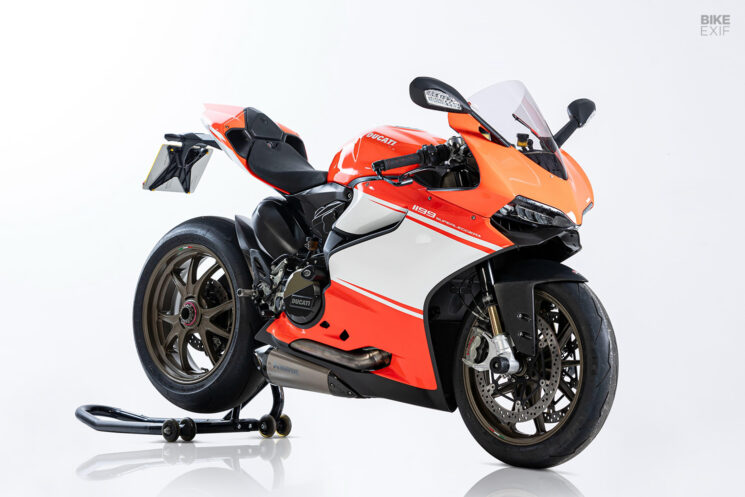
2014 Ducati 1199 Superleggera Capable of 195 hp and 202 mph with the track exhaust fit, Ducati’s homologated 2012 Panigale R was certainly a headline-grabbing machine. But if you’re a cutting-edge firm like Ducati, there’s always a little more to be had—a few pounds to shave, and 1,000 more rpm possible. Too hot for homologation, the 2014 1199 Superleggera was Ducati’s nth level of speed and weight savings from a decade ago—and still as impressive today.
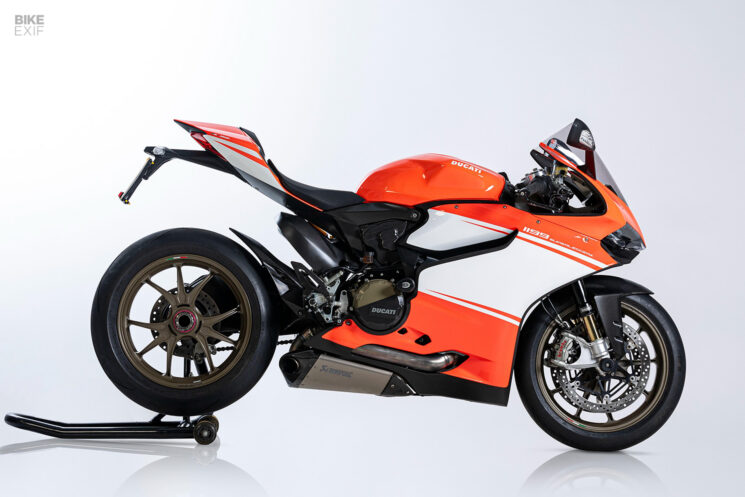
As the Superleggera name suggests, Ducati’s engineers were given free rein over exotic lightweight materials for the creation of this ultra-exclusive model. A magnesium monocoque frame replaces the standard aluminum monocoque, and the subframe and bodywork are carbon fiber. Even the trick electronically-controlled Öhlins suspension was lightened with machined aluminum parts and a titanium spring.
Tearing into the oversquare Superquadro desmodromic 90° L-twin, Ducati’s engineers upgraded all four valves to titanium, as with the connecting rods, and two-ring racing pistons up compression a point to 13.2:1. With these measures, the Superleggera’s mill turns 1,000 more rpm at 12,500.
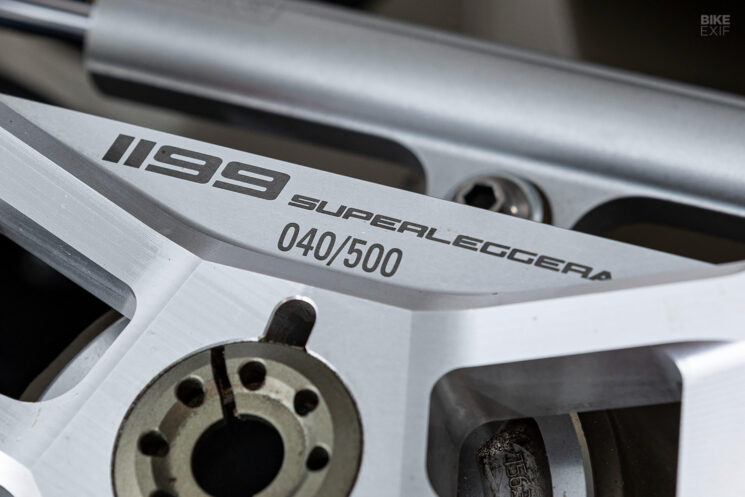
The result of all these measures is a 200-hp machine that weighs just 390 pounds at the curb—30 pounds less than the standard 1199 Panigale. Just 500 examples were built, making the bike too rare and too light for World Superbike homologation, and each one sold for $65,000.
Lot 127 is bike number 40 of 500, and saw limited dry-weather use of 3,967 miles. Not yet to the point of appreciation, Bonhams estimates the Ducati will sell for £38,000 to £42,000 [$47,845 to $52,881].
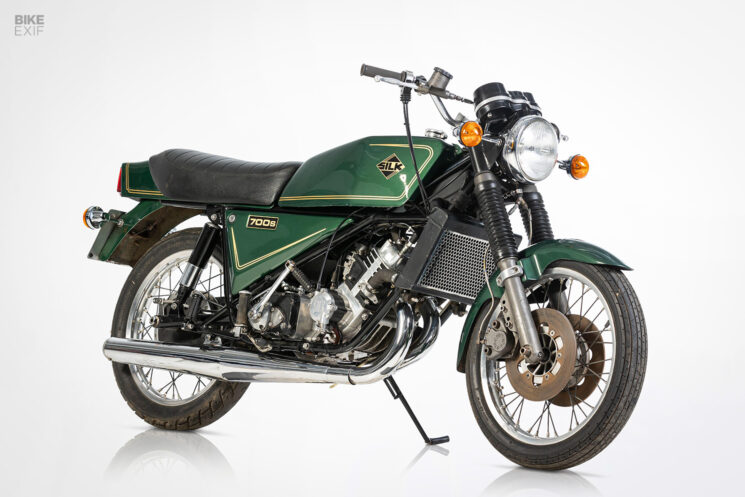
1978 SILK 653 cc 700S Mark 2 Setting up shop in the U.K. in the 1960s was a bold move, but George Silk had no shortage of inspiration. A Scott Motorcycle specialist, and a true enthusiast, Silk had built a two-stroke, Scott-powered special with a Spondon Engineering frame and made a decent showing at the Barbon Hill Climb in 1970.
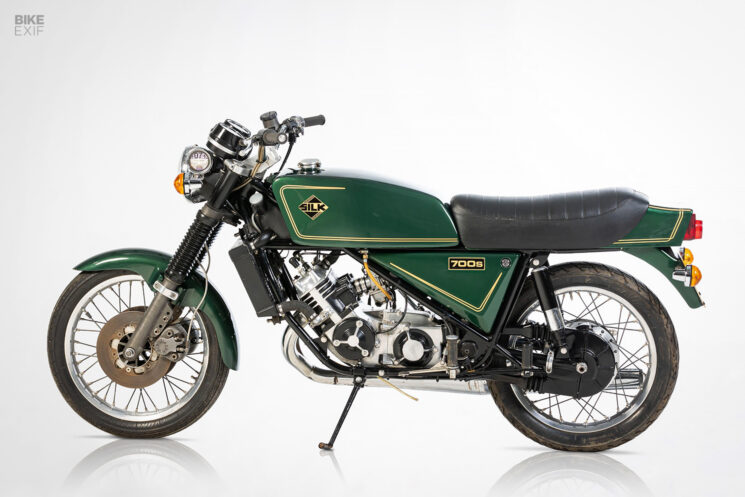
SILK Engineering went into business soon after, specializing in Scott Motorcycles, in addition to the development of a road-going version of Silk’s race machine. A subsequent trademark dispute with the owner of the Scott name forced Silk to find a new power plant for his production bike, and a water-cooled, two-stroke twin was soon developed by David Midgelow (of Rolls-Royce fame) based on the Scott Flying Squirrel.
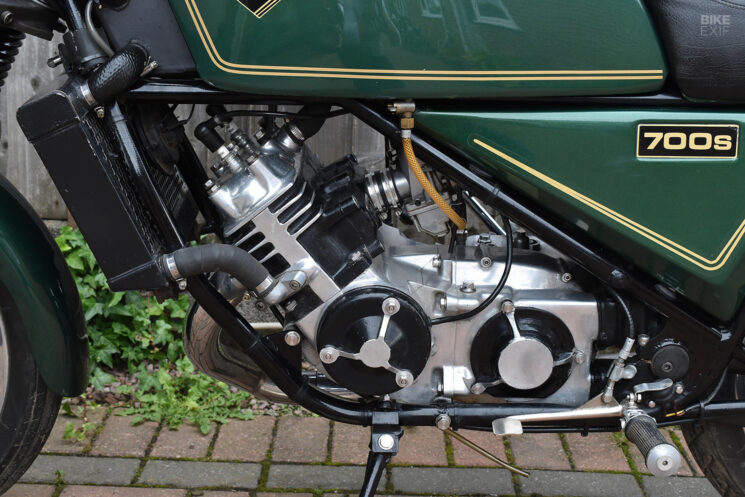
Powered by the new 653 cc water-cooled twin, Silk’s 700S model debuted in 1975 with a Spondon tubular steel frame and forks, and an inverted four-speed from the Velocette Venom. The 50:1 premix engine provided splendid performance to the tune of 48 bhp at 6,000 rpm, and the 700S would do 110 mph flat out.
Like many new endeavors, the 700S was priced high compared to the competition at £1,355, and SILK was taken over by Furmanite International Group in 1976. A short-lived Mark 2 version of the 700S followed, with improved compression, porting and bodywork, but SILK closed its doors for good by 1979.
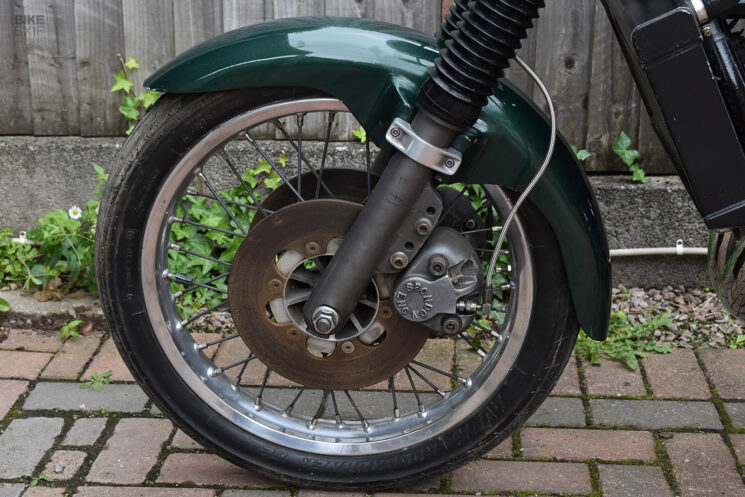
Lot 121 is beautifully represented 1978 700S Mark 2, offered with 23,160 miles on the odometer and rare spare parts supplied by specialist Clive Worrall. Bonhams estimates the 700S will sell for £7,500 to £10,000 [$9,438 to $12,584].
Images courtesy of Bonhams
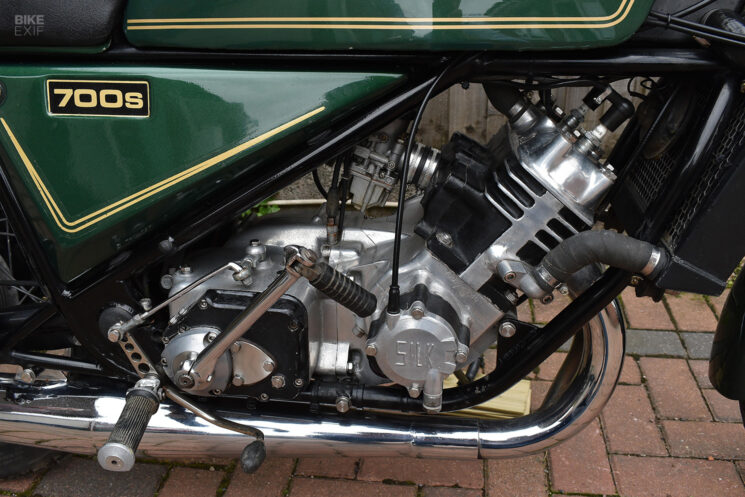
from Bike EXIF https://ift.tt/THvO2ne
No comments:
Post a Comment